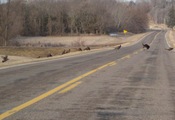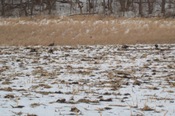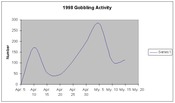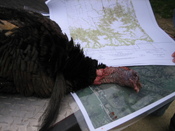 The MN season is upon us, and while some are scoring big early, others yet are finding henned-up gobblers and little gobbling activity. The good news is, that’s normal. The bad news is that it’s difficult to deal with. You’ll likely need to devote even more time to scouting to take a bird in these early seasons.
The MN season is upon us, and while some are scoring big early, others yet are finding henned-up gobblers and little gobbling activity. The good news is, that’s normal. The bad news is that it’s difficult to deal with. You’ll likely need to devote even more time to scouting to take a bird in these early seasons.
 Most state’s fish and game agencies set their season dates such that peak breeding occurs just before the general hunting season begins. But lets face it, 2009 thus far has been all winter with only a recent break in the weather for the most part. That stretch of dreary rain that lasted over a week set things back even further. So the situation you have now, is ready/willing hens and gobblers that know it.
Most state’s fish and game agencies set their season dates such that peak breeding occurs just before the general hunting season begins. But lets face it, 2009 thus far has been all winter with only a recent break in the weather for the most part. That stretch of dreary rain that lasted over a week set things back even further. So the situation you have now, is ready/willing hens and gobblers that know it.
 Some research done by T.R. Michels in SE MN has identified a series of "periods" of breeding activity that directly relate to the amount of gobbling you’ll hear. The primary breeding phase thus, is marked by an incredible lull in gobbling activity. The reason is that the toms are roosting right with their hens, so there’s little reason to provide audible contact when visual contact is right in front of them. It’s important to remember that this isn’t an exact science, and these are purely my observations of the several flocks that I’m watching. That said, all of the toms I’m seeing are locked TIGHT with their hens, and even roosting birds at night can be a chore. I’ve been lucky in that lately, my hens have been noisy heading up to the roost. I usually get a gobble from the boys with each fly-up cackle the hens do. Were it quiet, and I was wishing to elicit some gobbles of my own, some hard cutting or fly-up cackles would be a great way to get them to sound off.
Some research done by T.R. Michels in SE MN has identified a series of "periods" of breeding activity that directly relate to the amount of gobbling you’ll hear. The primary breeding phase thus, is marked by an incredible lull in gobbling activity. The reason is that the toms are roosting right with their hens, so there’s little reason to provide audible contact when visual contact is right in front of them. It’s important to remember that this isn’t an exact science, and these are purely my observations of the several flocks that I’m watching. That said, all of the toms I’m seeing are locked TIGHT with their hens, and even roosting birds at night can be a chore. I’ve been lucky in that lately, my hens have been noisy heading up to the roost. I usually get a gobble from the boys with each fly-up cackle the hens do. Were it quiet, and I was wishing to elicit some gobbles of my own, some hard cutting or fly-up cackles would be a great way to get them to sound off.
 What do to about it? Well, most articles you read regarding henned-up gobblers will offer sage advice on calling. I’ll do that too, but before that, I think the most important thing you can do is scout. Find out where they’re all roosting, where they’re all going, and why. Maps and air photos at this time are priceless. Use locator calls from distance so you don’t spook the flock. You won’t have to hen call much if you’re already smack dab where they’re going to be. If you’re already hunting and can’t scout, range and roam. Use some hard cutting on a box call, mouth-call, or loud slate….whatever it takes to get them to reveal their location. Then you’re in the game.
What do to about it? Well, most articles you read regarding henned-up gobblers will offer sage advice on calling. I’ll do that too, but before that, I think the most important thing you can do is scout. Find out where they’re all roosting, where they’re all going, and why. Maps and air photos at this time are priceless. Use locator calls from distance so you don’t spook the flock. You won’t have to hen call much if you’re already smack dab where they’re going to be. If you’re already hunting and can’t scout, range and roam. Use some hard cutting on a box call, mouth-call, or loud slate….whatever it takes to get them to reveal their location. Then you’re in the game.
great read joel and how true that is ive always said the best way to get a tom is to be where he wants to be
Excellent read Joel. Good luck Monday morning!

excellent read!
Word of wisdom Joel – thank you!
When scouting before dark and need to pinpoint a roosting tom, do you use a locater call (owl, hawk, crow) or do you use a hen call?
Hen call rarely if ever, even then it’s only if I’m confident they’re up in the trees. Sometimes, when it’s tough like this and they’re roosted with hens, I’ll hen call at night, get em fired up a bit. If I can see them, I’m looking for them to turn their body towards me and away from the hens. If they fall asleep that way, and wake up in the morning looking for me, and I’m there, I feel it’s easier to break them away. You’ve got to turn them on the limb away from their hens. With dry conditions like this however, I can’t get close enough in the woods now to make that work anyway.
Otherwise, I use a crow call as long as I can hear other crows calling, then switch to the owl call. That owl call usually makes them sound off if it’s quiet enough and they’re up on the limb.
Coyote howler out west or if I need the volume.
Joel